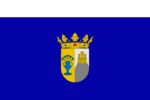
Summary
Zafra (Spanish pronunciation: [ˈθa.fɾa]; Extremaduran: Çafra) is a town in the Province of Badajoz (Extremadura, Spain), and the capital of the comarca of Zafra - Río Bodión. It has a population of 16,677,[2] according to the 2011 census.
Zafra | |
|---|---|
 The Castle of Zafra | |
 Flag | |
 Zafra Location in Spain. | |
| Coordinates: 38°25′N 6°25′W / 38.417°N 6.417°W | |
| Country | Spain |
| Autonomous community | Extremadura |
| Province | Badajoz |
| Comarca | Zafra - Río Bodión |
| Government | |
| • Mayor | Juan Carlos Fernández Calderón (Partido Popular) |
| Area | |
| • Total | 62.6 km2 (24.2 sq mi) |
| Elevation | 508 m (1,667 ft) |
| Population (2018)[1] | |
| • Total | 16,776 |
| • Density | 270/km2 (690/sq mi) |
| Demonym(s) | Zafrenses, Segedanos/as |
| Time zone | UTC+1 (CET) |
| • Summer (DST) | UTC+2 (CEST) |
| Website | Official website |
Zafra is the hometown of Fray Ruy Lopez, author of one of the first European treatises on chess, and the humanist Pedro de Valencia.
Roman era edit
Zafra has been associated with the Roman names Restituta Iulia Imperial,[3] Contributa Iulia Ugultunia,[4] and Segida Restituta Iulia,[4] though this applies equally to some of the other towns in the area.[5] The name Contributa Julia appears on an 1849 map[6] of Roman Hispania (in the south-west of Spain, in the area named Baeturia) alongside the name Regina (presently associated with the ruins of a small Roman town of the same name [citation needed][7]), lending some geographical support to the possibility of an association of the name Contributa Iulia or Contributa Julia with Zafra. Other sources, however, support an association of the name Segida Restituta Iulia with Zafra.[8][9] Yet other, authoritative, sources associate no Roman name with Zafra.[10] In the area round Zafra may be found the remains of as many as 20 Roman villas.[11] These, and associations between the name Restitutia Iulia and a migration from the legendary Segeda,[12] may be linked to the origin of the town.
References edit
- ^ Municipal Register of Spain 2018. National Statistics Institute.
- ^ "Zafra (Badajoz)". City Population. Thomas Brinkhoff. 2012-12-18. Retrieved 1 November 2013.
- ^ Qué Hacer | (switch to English) | Vía de la Plata (The Silver Route) | stage 3 at TurismoExtremadura.com.
- ^ a b Badajoz (search for: 'Zafra') at El Archivo Epigráfico de Hispania | Bases de datos y Archivo Virtual | Geographica (on map, click on: 'Badajoz').
- ^ Comarca de Zafra / Rio Bodión | La Comarca - Sus Municipios.
- ^ Hispania from Perry–Castañeda Library Map Collection | Spain Maps | Hispania (Ancient Spain).
- ^ Wikimapia location: ruins of Regina Roman town.
- ^ Atlas de la Historia del Territorio de Andalucía.
- ^ 'LA MUNICIPALIZACIÓN FLAVIA: ESTADO DE LA CUESTIÓN' (search for: 'Zafra') from 'LOS MUNICIPIOS FLAVIOS DE LA BÉTICA' by EVA Mª MORALES RODRÍGUEZ. Tesis Doctoral dirigida por Dr. Cristóbal González Román, DEPARTAMENTO DE HISTORIA, ANTIGUA FACULTAD DE FILOSOFIA Y LETRAS, UNIVERSIDAD DE GRANADA, Granada, 2000.
- ^ BARRINGTON ATLAS OF THE GREEK AND ROMAN WORLD, Gazeteer, page 430, Map 26 Lusitania-Baetica, Compiled by R.C. Knapp and F.H. Stanley, Jr. (Portugal), 1996, in file BATL026_.PDF in B_ATLAS.ZIP Archived 2013-05-07 at the Wayback Machine from Princeton University Press | Subjects | Browse Princeton Catalog by Subject | Archaeology and Ancient History | Archaeology and Ancient History | Barrington Atlas of the Greek and Roman World. R.J.A. Talbert, ed. Archived 2012-03-26 at the Wayback Machine | Barrington Atlas of the Greek and Roman World, Edited by Richard J. A. Talbert | Map-by-Map Directory.
- ^ LOS ROMANOS EN ZAFRA. ¿SEGEDA? (search for: 'villae'), from ZAFRA - LA SEGEDA DE LA BETURIA CÉLTICA.
- ^ Segeda and Rome. The historical development of a Celtiberian citystate. (page 11, section: 'A Segedan colonisation in the Celtic Baeturia') by Francisco Burillo Mozota, Centro de Estudios Celtibéricos de Segeda, Seminario de Arqueología y Etnología Turolense, Facultad de Humanidades y Ciencias Sociales de Teruel.


